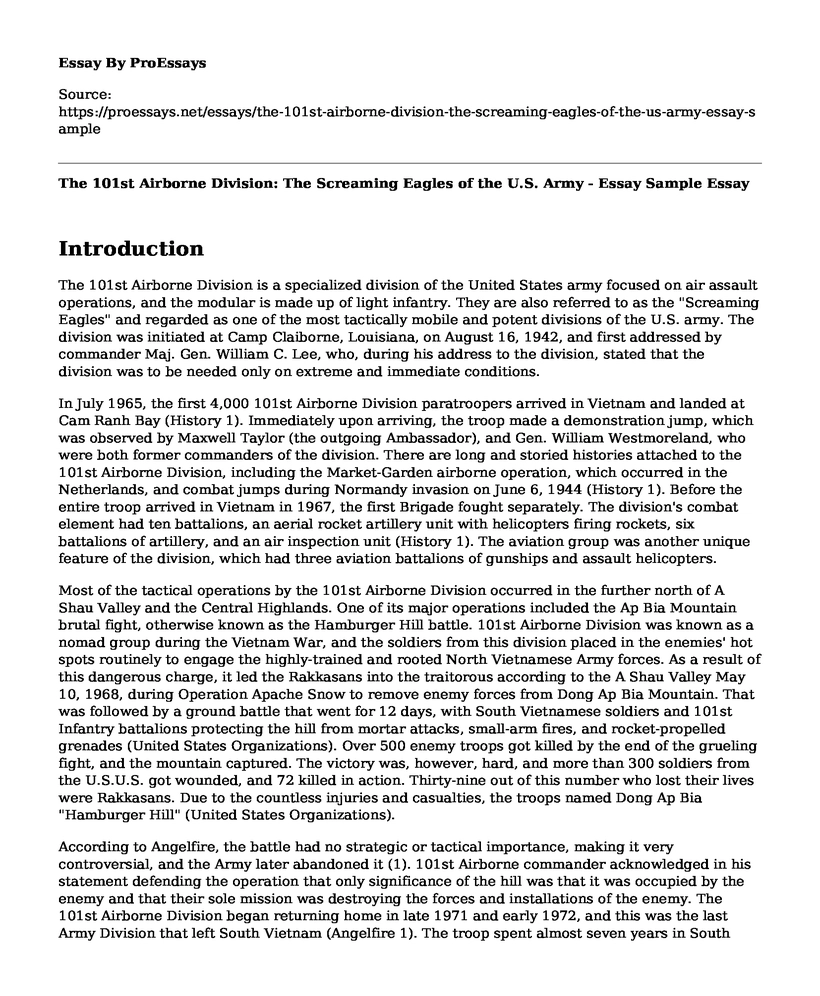Introduction
The 101st Airborne Division is a specialized division of the United States army focused on air assault operations, and the modular is made up of light infantry. They are also referred to as the "Screaming Eagles" and regarded as one of the most tactically mobile and potent divisions of the U.S. army. The division was initiated at Camp Claiborne, Louisiana, on August 16, 1942, and first addressed by commander Maj. Gen. William C. Lee, who, during his address to the division, stated that the division was to be needed only on extreme and immediate conditions.
In July 1965, the first 4,000 101st Airborne Division paratroopers arrived in Vietnam and landed at Cam Ranh Bay (History 1). Immediately upon arriving, the troop made a demonstration jump, which was observed by Maxwell Taylor (the outgoing Ambassador), and Gen. William Westmoreland, who were both former commanders of the division. There are long and storied histories attached to the 101st Airborne Division, including the Market-Garden airborne operation, which occurred in the Netherlands, and combat jumps during Normandy invasion on June 6, 1944 (History 1). Before the entire troop arrived in Vietnam in 1967, the first Brigade fought separately. The division's combat element had ten battalions, an aerial rocket artillery unit with helicopters firing rockets, six battalions of artillery, and an air inspection unit (History 1). The aviation group was another unique feature of the division, which had three aviation battalions of gunships and assault helicopters.
Most of the tactical operations by the 101st Airborne Division occurred in the further north of A Shau Valley and the Central Highlands. One of its major operations included the Ap Bia Mountain brutal fight, otherwise known as the Hamburger Hill battle. 101st Airborne Division was known as a nomad group during the Vietnam War, and the soldiers from this division placed in the enemies' hot spots routinely to engage the highly-trained and rooted North Vietnamese Army forces. As a result of this dangerous charge, it led the Rakkasans into the traitorous according to the A Shau Valley May 10, 1968, during Operation Apache Snow to remove enemy forces from Dong Ap Bia Mountain. That was followed by a ground battle that went for 12 days, with South Vietnamese soldiers and 101st Infantry battalions protecting the hill from mortar attacks, small-arm fires, and rocket-propelled grenades (United States Organizations). Over 500 enemy troops got killed by the end of the grueling fight, and the mountain captured. The victory was, however, hard, and more than 300 soldiers from the U.S.U.S. got wounded, and 72 killed in action. Thirty-nine out of this number who lost their lives were Rakkasans. Due to the countless injuries and casualties, the troops named Dong Ap Bia "Hamburger Hill" (United States Organizations).
According to Angelfire, the battle had no strategic or tactical importance, making it very controversial, and the Army later abandoned it (1). 101st Airborne commander acknowledged in his statement defending the operation that only significance of the hill was that it was occupied by the enemy and that their sole mission was destroying the forces and installations of the enemy. The 101st Airborne Division began returning home in late 1971 and early 1972, and this was the last Army Division that left South Vietnam (Angelfire 1). The troop spent almost seven years in South Vietnam, and during that time, 101st Airborne Division became one of the most feared units of the American Army.
Works Cited
Angelfire. "The 101st Airborne Division in Vietnam" (2014). Retrieved from www.angelfire.com/rebellion/101abndivvietvets/page15history101.html.
History. "101st Airborne Division arrives in Vietnam" (2009). Retrieved from www.history.com/this-day-in-history/101st-airborne-division-arrives-in-vietnam.
United States Organizations. "Here Are 7 Things You Need to Know About the 101st Airborne Division" (2017). Retrieved from www.uso.org/stories/2038-here-are-7-things-you-need-to-know-about-the-101st-airborne-division.
Cite this page
The 101st Airborne Division: The Screaming Eagles of the U.S. Army - Essay Sample. (2023, Mar 07). Retrieved from https://proessays.net/essays/the-101st-airborne-division-the-screaming-eagles-of-the-us-army-essay-sample
If you are the original author of this essay and no longer wish to have it published on the ProEssays website, please click below to request its removal:
- Research Project on Health Care for Veteran Women
- Personal Reflection Essay on Hiroshima and Nagasaki Bombings
- Veterans Reactions to Their Experiences of the First World War and Homecoming
- Gen. John "Jay" Raymond Speech Outline
- Wounded Warrior Project Paper Example
- Book Analysis Essay on Tribe by Sebastian Junger
- Essay Sample on Drone Strikes: A Legal Controversy







